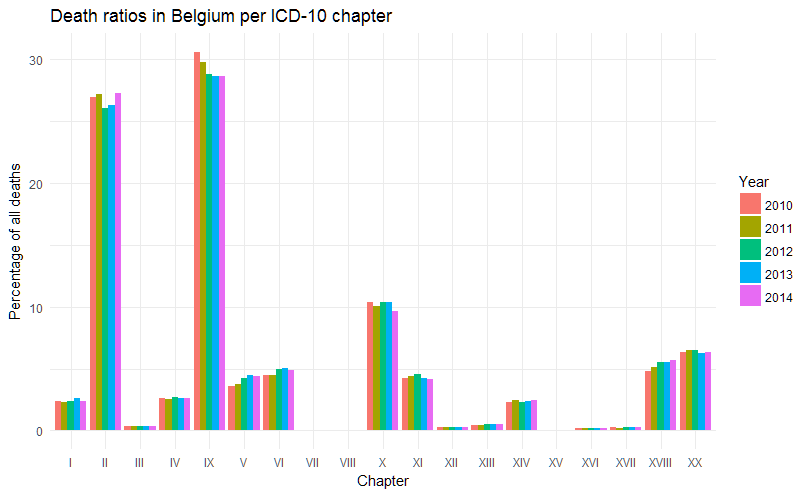Since the beginning of the COVID-19 pandemic, we suspected and saw that nursing homes and other facilities where people are grouped together (prisons, …) could be at higher risk of transmission. The focus on nursing homes was because deaths seem to disproportionately affect the older population that also resides there. And nursing homes are also home for frail people with comorbidities.
In its dashboard, the Maryland Department of Health quickly started to build a dedicated page with numbers from different “congregate facility settings”. As I did for other metrics from this dashboard, I made a chart of what seemed the cumulative total cases, differentiating staff (who are stuck working there) and residents (who stuck living in these facilities):

Besides the weekly update (contrasting with the daily update on the main dashboard), the strange thing is that curves are going down! If it was a true cumulative curve, it would keep either growing (new cases are added) or it will go flat where it reached (no new case, we keep the total from last day or week).
Then you read the note below the dashboard (before the tables) and it says:
Facilities listed above report at least one confirmed case of COVID-19 as of the current reporting period. Facilities are removed from the list when health officials determine 14 days have passed with no new cases and no tests pending.
I could imagine that the reason is pragmatic: somewhere, someone stops adding cases (or deaths) if the facility doesn’t send new case (or new death) count for 14 days. But it doesn’t make sense to actively remove the facility from the list and therefore remove the cases (or deaths) that were reported earlier. Especially if the dashboard leads viewers in error by stating “Total # of Cases” as y-axis:

Melissa Schweisguth reported an article from the Baltimore Sun pointing to this discrepancy and current state of discussion (but no solution reported) in this tweet:
The article quotes the Department of Health mentioning that the other data presented is cumulative but I couldn’t find this … Indeed all datasets available include the same caveat that facilities not reporting within 14 days are removed:
- Total cases in congregate facility settings: removes the data
- Total deaths in congregate facility settings: removes the data
- Number of cases by affected congregate facility: removes the data
- Number of deaths by affected congregate facility: removes the data
- Total cases by congregate facility settings by County: removes the data
- Total deaths by congregate facility settings by County: removes the data
If I take an example in the first few facilities that reported cases, we clearly see that this one (whichever it is, it doesn’t matter here) started to report cases up to June 10. Since I’m writing this on June 25, there are more than 14 days that they stopped reporting, the dataset doesn’t include this facility anymore (the latest data points in the dataset are for June 24):

This is a pity because, besides the difference between residents and staff, these datasets also present cases and deaths among youth and inmates. It would have been nice to understand the evolution of the burden of COVID-19 in these populations. But the curve is clearly not cumulative, as we can seen on the charts below: after about June 2nd-10th, curves going down probably indicate removal of facilities in the total count.

As mentioned in the Baltimore Sun article, with this kind of reporting, you cannot know the real toll in nursing home, prisons and other congregate facility settings and therefore you cannot respond to it appropriately (i.e. the toll is now underestimated).
Also, you can’t put things in perspective because you can’t have a reliable proportion of cases in congregate facility settings compared to the total number of COVID-19 cases in Maryland. This total number of cases is cumulative and we see an artificial decrease in % of cases in these facilities, as illustrated below:

Now, what can we do? One clear solution is that the Maryland Department of Health changes its reporting and really report the correct cumulative number of cases in congregate facility settings. Besides that, I have a technical solution in mind but I had no time today to code it yet …
To be continued …
As usual, you’ll find other graphs on my page about COVID-19 in Maryland (and figures above are updated with new data as they appear) and the data, code and figures are on Github (including these ones).
Post-scriptum on June 26, 2020: the day after I posted this, Maryland Governor Larry Hogan announced a safe and phased reopening plan for Maryland’s assisted living facilities. Although I welcome any initiative targeting the protection of everyone and especially the most vulnerable populations, the 2 first prerequisites are still tied to this absence of new cases in 14 days (which is fine) – this is still not a reason to intentionally remove facilities from the count. And I couldn’t see the phased approach – but I guess this will be followed up in another post here. To be continued …
























